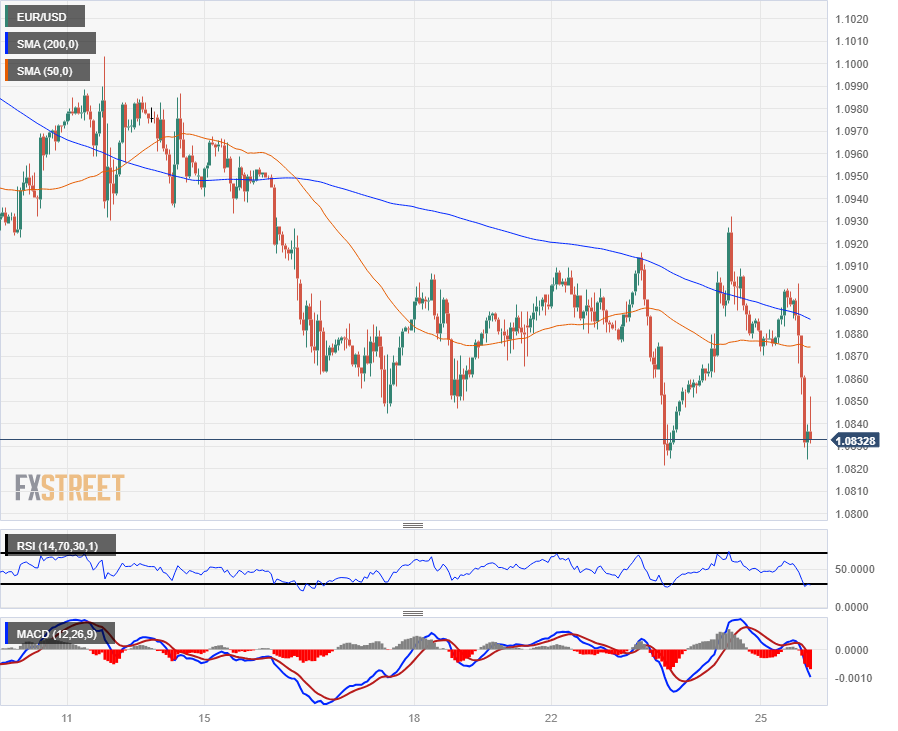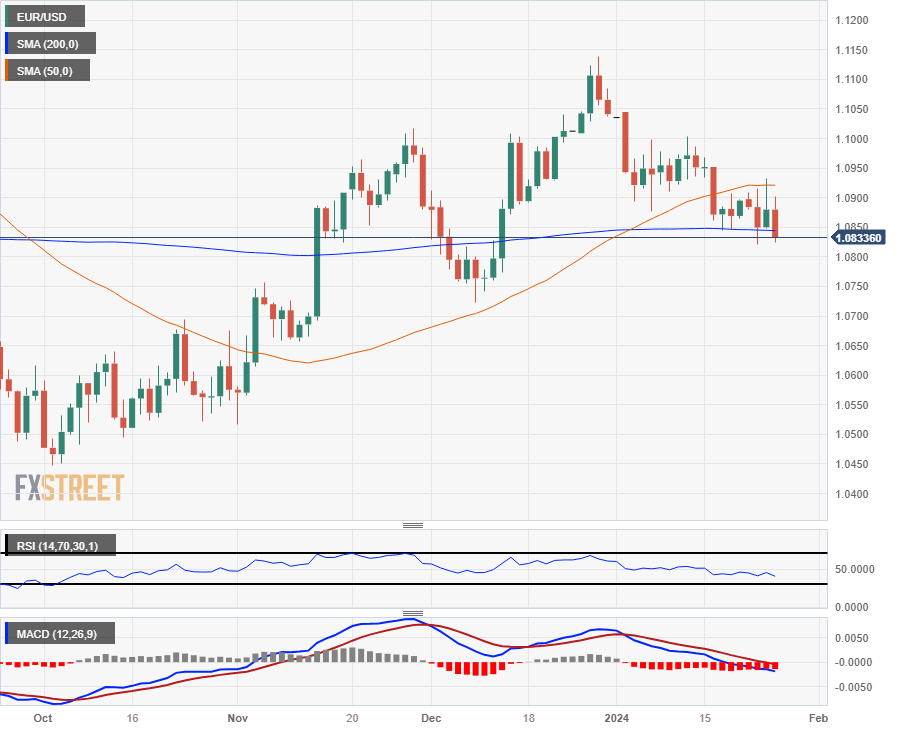- The Euro falls from known technical levels after the ECB offers a dovish stance.
- In Europe, not much economic data will be released until next Tuesday's GDP update.
- Broader markets will focus on Friday's US PCE Price Index to close out the trading week.
The Euro (EUR) fell on Thursday after the European Central Bank (ECB) showed a dovish stance during its latest monetary policy statement, causing the euro to decline against most of its major peers. Money markets added to bets on a 50 basis point rate cut by the ECB by June, despite strong language from ECB President Christine Lagarde warning that the consensus within the ECB is that the discussion of Rate cuts are too premature in the face of price risks from rising wages and a still robust labor market.
There will be no economic data released in Europe for the rest of the week, with markets focusing on the US Personal Consumption Expenditure Price Index (IPCE) figures, a snapshot of inflation, due out on Friday. . European investors will have to wait until next Tuesday's EU Gross Domestic Product (GDP) update for economic headlines on the Euro side.
Daily market summary: ECB is dovish and Euro falls on Thursday
- European Central Bank President Christine Lagarde warned Thursday that risks remain and that it is too early to start talking about rate cuts.
- Despite easing economic conditions and stagnating growth figures from Europe, key inflation risks remain high.
- Lagarde, President of the ECB, affirms that the increases in interest rates are beginning to be transmitted “strongly to financing conditions.”
- The ECB highlighted the inflation risks derived from tensions in the Middle East, the economy needs more time to advance in the disinflation process.
- Despite declines in some measures, domestic price pressure remains high overall.
- European money markets added bets on rate cuts of 50 basis points until June and 150 basis points until the end of 2024, rising after the ECB's rate request.
- ECB press conference: Lagarde explains decision to keep rates stable, talks about political outlook
- In the United States, GDP growth in the fourth quarter exceeded expectations.
- Fourth-quarter US GDP grew 3.3%, compared to the forecast of 2.0%, declining less than expected from 4.9% in the previous quarter.
- Initial US jobless claims also rose to 214,000 in the week ended January 19, above the forecast of 200,000, up from 189,000 the previous week (revised upward from 187,000).
- Initial jobless claims surpassed the four-week average of 202,250.
- US per capita consumer price index figures will be released on Friday, and markets will focus on key inflation data for the Fed's guidance.
The price of the Euro today
Below is the percentage evolution of the euro (EUR) against the main currencies. The Euro was the strongest currency against the Swiss franc.
| USD | EUR | GBP | CAD | AUD | JPY | NZD | CHF | |
| USD | 0.44% | 0.26% | -0.18% | 0.02% | 0.19% | -0.04% | 0.52% | |
| EUR | -0.45% | -0.17% | -0.63% | -0.45% | -0.26% | -0.51% | 0.09% | |
| GBP | -0.27% | 0.17% | -0.45% | -0.27% | -0.08% | -0.33% | 0.25% | |
| CAD | 0.17% | 0.62% | 0.44% | 0.18% | 0.36% | 0.12% | 0.70% | |
| AUD | 0.00% | 0.43% | 0.25% | -0.19% | 0.19% | -0.06% | 0.53% | |
| JPY | -0.19% | 0.26% | 0.07% | -0.37% | -0.19% | -0.24% | 0.33% | |
| NZD | 0.08% | 0.49% | 0.32% | -0.13% | 0.06% | 0.25% | 0.57% | |
| CHF | -0.54% | -0.10% | -0.27% | -0.71% | -0.52% | -0.33% | -0.59% |
The heat map shows the percentage changes of the major currencies against each other. The base currency is chosen in the left column, while the quote currency is chosen in the top row. For example, if you choose the euro in the left column and scroll down the horizontal line to the Japanese yen, the percentage change in the box will represent EUR (base)/JPY (quote).
Technical Analysis: The euro gives in to the ECB's tone, the EUR/USD pair rejects 1.0900 again
The Euro (EUR) fell against the US Dollar (USD) on Thursday, pulling back and dragging EUR/USD back below the 1.0900 zone and seeing another technical rejection of the 200 hourly SMA near 1.0885.
The pair has fallen back to a known low, with bids locked at the 200-day SMA near 1.0840. The EUR/USD pair is caught in a widening congestion trap between the 50-day and 200-day SMA as the technical consolidation pattern continues to hamper significant momentum in either direction.
EUR/USD Hourly Chart
EUR/USD Daily Chart
Frequently asked questions about the euro
What is the euro?
The Euro is the currency of the 20 countries of the European Union that belong to the Eurozone. It is the second most traded currency in the world, behind the US dollar. In 2022, it accounted for 31% of all foreign exchange transactions, with an average daily volume of more than $2.2 trillion per day.
EUR/USD is the most traded currency pair in the world, accounting for an estimated 30% of all transactions, followed by EUR/JPY (4%), EUR/GBP (3%) and EUR/AUD (2% ).
What is the ECB and how does it influence the euro?
The European Central Bank (ECB), headquartered in Frankfurt, Germany, is the reserve bank of the euro zone. The ECB sets interest rates and manages monetary policy.
The ECB's main mandate is to maintain price stability, which means controlling inflation or stimulating growth. Its main instrument is to raise or lower interest rates. Relatively high interest rates – or the expectation of higher rates – tend to benefit the euro and vice versa.
The Governing Council of the ECB takes monetary policy decisions at meetings held eight times a year. Decisions are made by the heads of the eurozone's national banks and six permanent members, including ECB President Christine Lagarde.
How do inflation data influence the value of the euro?
Eurozone inflation data, measured by the Harmonized Index of Consumer Prices (HICP), is an important econometric data for the euro. If inflation rises more than expected, especially if it exceeds the 2% target set by the ECB, it is forced to raise interest rates to bring it back under control.
Relatively high interest rates compared to their peers tend to benefit the euro, making the region more attractive as a place for global investors to park their money.
How do economic data influence the value of the euro?
Data releases measure the health of the economy and can influence the euro. Indicators such as GDP, manufacturing and services PMIs, employment and consumer sentiment surveys can influence the direction of the single currency.
A strong economy is good for the euro. Not only does it attract more foreign investment, but it may encourage the ECB to raise interest rates, which will directly strengthen the euro. Conversely, if economic data is weak, the euro is likely to fall.
The economic data for the four largest economies in the Eurozone (Germany, France, Italy and Spain) are especially significant, as they represent 75% of the Eurozone economy.
How does the Trade Balance affect the euro?
Another important publication for the euro is the Trade Balance. This indicator measures the difference between what a country earns from its exports and what it spends on imports during a given period.
If a country produces highly sought-after export products, its currency will appreciate due to the additional demand created by foreign buyers wishing to purchase these goods. Therefore, a positive Net Trade Balance strengthens a currency and vice versa for a negative balance.
Source: Fx Street
I am Joshua Winder, a senior-level journalist and editor at World Stock Market. I specialize in covering news related to the stock market and economic trends. With more than 8 years of experience in this field, I have become an expert in financial reporting.







